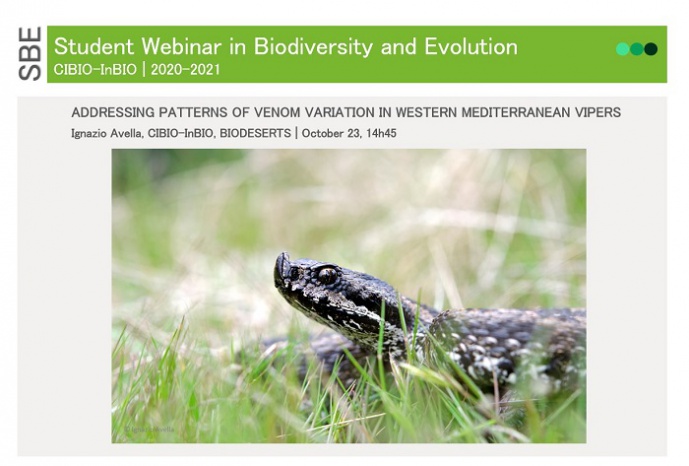Addressing patterns of venom variation in Western Mediterranean vipers

STUDENT WEBINAR IN BIODIVERSITY AND EVOLUTION
Snake venoms are complex secretions of bioactive molecules able to disrupt the physiological equilibrium of the organism in which they are injected, known to be used for both predatory and defensive purposes. Several studies have found evidence of adaptation in the composition of snake venoms to diet, reinforcing their role as targets for natural selection, and explaining their geographic variation with different prey preferences. However, other factors (e.g. phylogenetic relationships) might be relevant in shaping the composition of snake venoms, determining the presence of similarities or differences in quantity and/or type of venom components. Vipers (Family Viperidae) are one of the most diverse groups of venomous snakes worldwide, infamous for the generally high potency of their venoms. The Western Mediterranean Basin is home to nine viper species, most of which considered as highly medically important and potentially lethal by the World Health Organization. Nevertheless, geographic variation in the composition of venoms produced by these species has been scarcely addressed so far. The main aim of my PhD project is to define the variation in the protein composition of venoms produced by different species of Iberian and Moroccan viper species. Through the application of a multidisciplinary approach centred around venom proteomics, venoms will be characterized and analysed at inter- and intraspecific level, and at local and regional scale. The obtained venom profiles will ultimately be correlated with diet, phylogenetic relationships, and environmental variables, to unravel the potential role of these factors as drivers of venom variation.
Ignazio Avella got his MSc in Environmental Biology at "La Sapienza” University of Rome (Italy), with a thesis on phylogeography and phenotypic variation of the western whip snake Hierophis viridiflavus. A life-long herp enthusiast, specifically fascinated by reptiles and their forms of adaptation to extreme and complex environments, he has worked as scientific divulgator, dissertation advisor and field herpetologist on scientific expeditions in Mexico and Peru. Ignazio is currently developing his PhD project under the supervision of Dr. Fernando Martínez-Freiría (CIBIO-InBIO, BIODESERTS and PHENEVOL research groups), Dr. Wolfgang Wüster (Bangor University, Wales) and Prof. Dr. Juan J. Calvete (Institute of Biomedicine of Valencia – CSIC, Spain). The aim of his project is to define how the venoms of different viper species from North-West Africa and the Iberian Peninsula vary at both inter- and intraspecific level, through the application of a multidisciplinary approach centred around venom proteomics. To this date, Ignazio has collaborated with the Liverpool School of Tropical Medicine (England) and the University of Sheffield (England).
[Host: Fernando Martínez-Freiría, BIODESERTS, PHENEVOL]